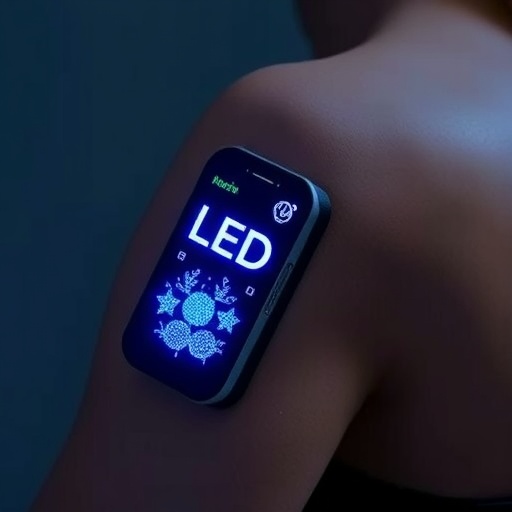In the wake of the global COVID-19 pandemic, public consciousness surrounding personal health and hygiene has reached unprecedented levels. This heightened awareness has accelerated research into innovative medical technologies that not only combat infections but do so in ways that are more user-friendly and accessible than traditional treatments. Among these emerging frontiers is a fascinating convergence of wearable technology and natural antibacterial agents, heralding a new era in combating drug-resistant pathogens such as Staphylococcus aureus.
Staphylococcus aureus, a common bacterium often found on skin and nasal passages, poses a serious health risk due to its ability to develop resistance against multiple antibiotics. The rise of multidrug-resistant strains has confounded modern medicine, making infections increasingly difficult to treat and control. In this challenging context, researchers have been rigorously exploring alternative antimicrobial strategies that circumvent conventional antibiotic pathways, thus reducing the potential for resistance development.
The recent breakthrough involves the integration of wearable organic light-emitting diode (OLED) technology with natural antibacterial substances to create a synergistic antibacterial platform. OLED technology, well-known for its use in flexible screens and lighting, offers unique advantages when adapted for medical use: it is lightweight, flexible, and can be designed to emit precise wavelengths of light capable of disrupting bacterial pathogens. When combined with the inherent antimicrobial properties of certain natural compounds, this approach promises to deliver enhanced bactericidal effects against resistant strains.
Researchers focused on OLED devices that emit blue light, a spectrum well-documented for its ability to generate reactive oxygen species (ROS) in microbial cells. These ROS can cause oxidative damage to bacterial membranes and DNA, leading to bacterial cell death. The wearable format of OLEDs enables continuous, targeted exposure to this antibacterial light directly on the skin or wound sites, thus maximizing therapeutic efficacy without systemic side effects common in antibiotic treatments.
Complementing the photodynamic antimicrobial effect, the research incorporated natural antibacterial agents derived from plants known for their bioactive properties, such as essential oils, flavonoids, and phenolic compounds. These substances have been historically recognized for their ability to disrupt bacterial metabolism and biofilm formation, which is crucial because biofilms offer bacteria a protected environment against antibiotics. When combined with blue light exposure, these natural agents demonstrated a marked increase in their bactericidal activity.
Experimental validation involved exposing multidrug-resistant Staphylococcus aureus cultures to the combined treatment of wearable OLED light irradiation and topical application of natural antibacterial substances. The results showed a significantly enhanced inhibition of bacterial growth compared to either treatment used alone. This synergy suggests a promising route to effectively suppress or even eradicate stubborn bacterial populations that no longer respond to conventional antibiotics.
Another compelling advantage of this platform lies in its usability and convenience. Unlike systemic antibiotic therapies, which require strict dosing schedules and can cause adverse effects, the wearable OLED-based treatment can be easily applied and controlled by the user. This opens the door to personalized, ambulatory care models that empower patients to manage bacterial infections proactively in community or home settings.
From a technical perspective, the OLED devices are engineered to maintain stable emission intensities over extended periods, ensuring consistent antibacterial activity. The devices’ flexibility allows them to conform to various body contours such as joints or wound areas, overcoming one of the major limitations of traditional rigid light sources. Moreover, researchers have optimized the light intensity and wavelength to maximize ROS production without causing tissue damage, a crucial balance in phototherapy.
In addition to photodynamic and natural antimicrobial actions, the combined platform also appears to disrupt quorum sensing—a bacterial communication process that regulates virulence and resistance gene expression. By interfering with this signaling, the treatment not only attacks the bacteria directly but also diminishes their ability to coordinate defense mechanisms, increasing their susceptibility to clearance.
The implications of this research extend far beyond staphylococcal infections. The strategy could be adapted to target a variety of multidrug-resistant bacterial species that pose a threat in hospital and community environments. Given the flexibility of OLED fabrication and the diversity of natural antibacterial agents available, this platform is poised to become a versatile and scalable solution in the fight against antibiotic resistance.
Looking ahead, ongoing studies aim to further refine the wearable devices’ integration with biosensors, enabling real-time monitoring of infection biomarkers and dynamic adjustment of light therapy parameters. Such smart systems could revolutionize treatment personalization, reducing overtreatment risks and promoting optimal therapeutic outcomes.
As antibiotic resistance continues to endanger global health, innovative approaches like the OLED-natural substance synergy present a beacon of hope. By merging cutting-edge light-emitting technology with traditional antimicrobial wisdom, the research heralds a future where managing bacterial infections is safer, more effective, and accessible outside clinical settings.
This pioneering research underscores the critical importance of interdisciplinary collaboration, drawing from materials science, microbiology, photonics, and pharmacology. It embodies a paradigm shift toward non-invasive, resistance-mitigating therapies that align with modern healthcare’s demands for sustainability and patient-centeredness.
In conclusion, the combined use of wearable organic light-emitting diodes and natural antibacterial agents marks an exciting advancement in antimicrobial technology. Its ability to enhance antibacterial activity against multidrug-resistant Staphylococcus aureus and potentially other pathogens offers a promising new weapon in the global fight against drug-resistant infections. As further development continues, such innovations may soon become standard tools in individualized health management and infection control worldwide.
Subject of Research: Synergistic antibacterial activity of wearable organic light-emitting diodes combined with natural antibacterial substances against multidrug-resistant Staphylococcus aureus.
Article Title: Synergizing Wearable OLED Phototherapy and Natural Antibacterials to Combat Multidrug-Resistant Staphylococcus aureus.
News Publication Date:
Web References:
References:
Image Credits:
Keywords: wearable OLED, natural antibacterial substances, Staphylococcus aureus, multidrug resistance, photodynamic therapy, organic light-emitting diodes, antibacterial synergy, reactive oxygen species, biofilm disruption, antimicrobial resistance, health management, innovative infection control




